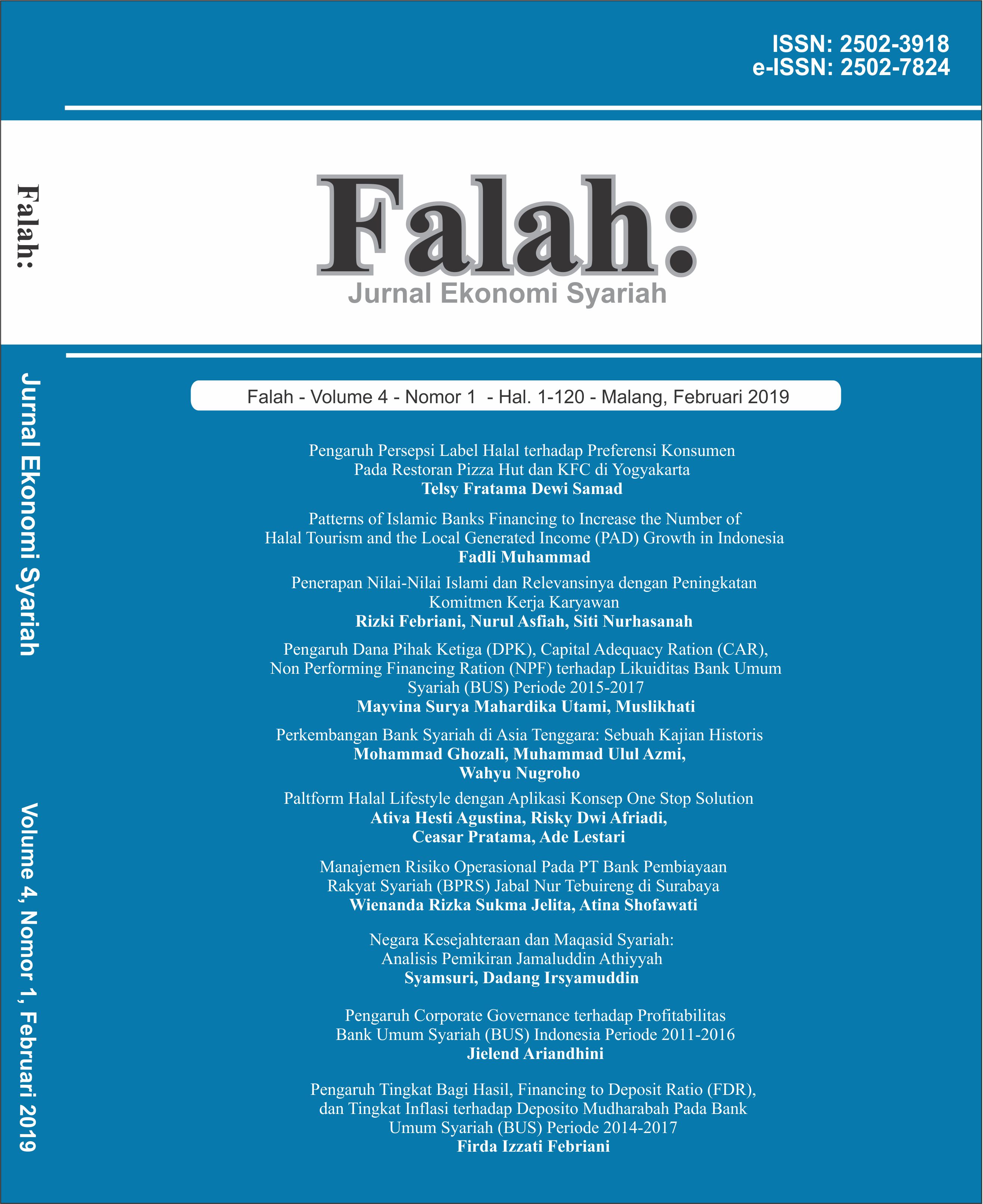Patterns of Islamic Banks Financing to Increase the Number of Halal Tourism and the Local Generated Income (PAD) Growth In Indonesia
DOI:
https://doi.org/10.22219/jes.v4i1.8492Keywords:
Financing, Islamic banks, Halal tourism.Abstract
This study aims to analyze the relationship of Islamic bank financing to the increase the number of halal tourists and the growth the local generated income (PAD) period 2015-2016 in 33 provinces, Indonesia. Using the research method is granger causality and panel data multiple regression with the Minitab analytical tool. This model analyzes the influence of Islamic bank financing contributions to the number of halal tours and the local generated income. The amount of Islamic banks financing in the tourism sector such as restaurant and tourism business has contributed to increase the number of halal tourists and the growth of the local generated income (PAD). The results of this study can be used for the Islamic banking industry to support capital financing for the halal industry. In previous studies only analyzed the halal tourism potential, as well as the potential of the tourism industry in general for the local generated income. However, this study discusses the contribution of Islamic bank financing to the number of halal tourism and an increase in the local generated income.
Downloads
References
Dar, A. A., & Mehta, S. K. (2014). Assessment of the Role of Financial Institutions in Tourism Development of Kashmir: A Field Study from Demand Side of Market. Journal of Kashmir for Tourism and Catering Technology, 14-24.
Din, K. H. (1989). Islam & Tourism. Annals of Tourism Research, 542-563.
DSN MUI, (2016). Pedoman Penyelenggaraan Pariwisata Berdasarkan Prinsip Syariah. Fatwa MUI (hal. 1-9). Jakarta: DSN MUI.
Duman, T. (2011). The Value of Islamic Tourism: Perspective from the Turkish Experience. Islam and Civilisational renewal, 718-738.
Fitri, D., Ansofino, & Desi Areva. (2014). Tourism Sector Effect on Local Revenue (PAD) in the district of Pesisir Selatan. Pendidikan EKonomi dan Bisnis STKIP PGRI Sumatera Barat, 2-15.
Hawkins, D. E., & Mann, S. (2007). The World Bank's Role in Tourism Development. Annals of Tourism Research, Vol. 34, No. 2, 348-363.
Jafari, J., & Scott, N. (2014). Muslim world and its tourisms. Annals of Tourism Research, 1-19.
Jamal, & Lee, J. H. (2013). Integrating Micro and Macro Approaches to Tourist Motivations: Toward an Interdisciplinary Theory. Tourism Analysis, 47-59.
Kadhim, F. A., Abdullah, T. F., & Mahir, F. A. (2016). Effects of Marketing mix on customer satisfication: empirical study on tourism industry in Malaysia. International Journal of Applied Research, 357-360.
Kamarudin, L. M. (2012). Muslim Tourists’ Typology In Malaysia: Perspectives And Cahllenges. Tourism and Hospitality International Conference, 1-8.
Kemenpar. (2015). Laporan Akhir Kajian Pengembangan Pariwisata Syariah. Jakarta: Kementrian Pariwisata.
Laderlah all, S. A. (2011). A Study on Islamic Tourism A Malaysia Experience. Internasional COnference on Humanities, Historical and Social Science, 1-6.
Master Card & Crescentrating. (2016). Global Muslim Travel Index 2016. Singapore: Master Card Asia Pasific & Crescentrating.
Mohamed Battour, M. N. (2015). Halal tourism: Concepts, practises, challenges and future. Tourism Management Perspectives, 150-154.
Muhamed, N. A., Ramli, N. M., Aziz, S. A., & Yaakub, N. A. (2014). Integrating Islamic Financing and Halal Industry: A Survey on Current Practices of the Selected Malaysian Authority Bodies. Asian Social Science; Vol. 10, No. 17, 1-7.
OIC, (2015). International Tourism in the OIC Countries: Prospects and Challenges. Ankara Turkey: The Statistical, Economic and Social Research and Training Cenre for Islamic Countries.
Paingpis Sriprasert, O. C. (2014). Understanding Behaviour and Needs of Halal Tourism in ANdaman Gulf of Thailand: A Case fo Asian muslim. Journal of Advanced Management Science, 216-219.
PERIĆ, J., MUJAČEVIĆ, E., & ŠIMUNIĆ, M. (2010). International financial institution investments in tourism and hospitality. Journal of International Business and Cultural Studies, 1-17.
Poria, Y. B. (2003). The Core of Heritage Tourism. . Annals of Tourism Research, Vol. 30, No. 1, 238–254.
Sheth, J. N. (1981). An Integrative Theory of Patronage Preference. Champaign, Illinois, Amerika Serikat: University of Illinois, Urbana-Champaign.
Sidharta, R. B. (2017). Optimalisasi Peran Perbankan Syariah Dalam Mendukung Wisata Halal. Jurnal Distribusi Manajemen dan Bisnis, 1-14.
Sriprasert, Chainin, & Rahman. (2014). Understanding Behavior and Needs of Halal Tourism in Andaman Gulf of Thailand: A Case of Asian Muslim. Journal of Advanced Management Science, 2 (3), 216-219.
Sterren, J. v. (2008). Financial Markets, Microfinance and Tourism in Developing Countries. Journal International economic NHTV Breda University of Applied Sciences, Breda, the Netherlands, 35-44.
Sulistiana. (2016). Analisis Pengaruh Sektor Pariwisata Terhadap Tingkat Penyerapan Tenaga Kerja Dan Pendapatan Asli Daerah Di Lombok 2009-2015. Jurnal Manajemen dan Bisnis, 1-20.
Thomson Reuters Islamic Finance. (2016). State of Global Islamic Economy Report. New York, USA: Thomson Reuters Islamic Finance & Dinar Standard.
UNWTO. (2016). Tourism Highlight. Madrid: World Tourism Organization.
Downloads
Published
How to Cite
Issue
Section
License
Authors who publish with this journal agree to the following terms:- Authors retain copyright and grant the journal right of first publication with the work simultaneously licensed under a Creative Commons Attribution License that allows others to share the work with an acknowledgement of the work's authorship and initial publication in this journal.
- Authors are able to enter into separate, additional contractual arrangements for the non-exclusive distribution of the journal's published version of the work (e.g., post it to an institutional repository or publish it in a book), with an acknowledgement of its initial publication in this journal.
- Authors are permitted and encouraged to post their work online (e.g., in institutional repositories or on their website) prior to and during the submission process, as it can lead to productive exchanges, as well as earlier and greater citation of published work (See The Effect of Open Access).

This work is licensed under a Creative Commons Attribution-ShareAlike 4.0 International License.


















